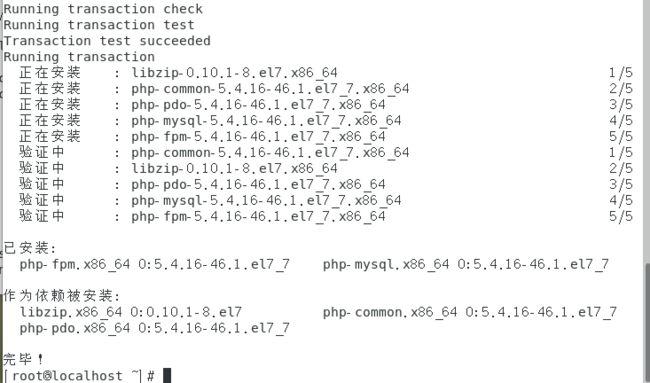基于 CentOS 搭建 WordPress 个人博客
1.准备 LNMP 环境
LNMP 是 Linux、Nginx、MySQL 和 PHP 的缩写,是 WordPress 博客系统依赖的基础运行环境。我们先来准备 LNMP 环境
1.1.安装 Nginx
安装过程参考博客:使用nginx将阿里云服务器升级为https
安装成功后在浏览器中输入虚拟机ip地址,来确认是否已经安装成功。下面是成功过界面
将 Nginx 设置为开机自动启动:
chkconfig nginx on
1.2.安装 MySQL
安装MySQL参考博客:Centos7安装和配置MySQL5.7
安装成功连接MySQL如下:
1.3.安装 PHP
使用 yum 安装 PHP:
yum install php-fpm php-mysql -y
安装成功:
安装之后,启动 PHP-FPM 进程:
service php-fpm start
启动之后,可以使用下面的命令查看 PHP-FPM 进程监听哪个端口
netstat -nlpt | grep php-fpm
把 PHP-FPM 也设置成开机自动启动:
chkconfig php-fpm on
PHP-FPM 默认监听 9000 端口
2.安装 WordPress
2.1.下载配置 WordPress
配置好 LNMP 环境后,开始下载 WordPress:
wordpress各种版本安装包:wordpress官网
wget https://cn.wordpress.org/wordpress-4.8.3-zh_CN.tar.gz
如果不能下载,请去资源界面软件部分下载压缩包:网站资源 ;解压:
tar -zxvf wordpress-4.8.3-zh_CN.tar.gz
文件目录
安装完成后,就可以在 /usr/share/wordpress 看到 WordPress 的源代码了。
连接MySQL
mysql -u root -p
为 WordPress 创建一个数据库:
CREATE DATABASE wordpress;
MySQL 部分设置完了,我们退出 MySQL 环境:
exit
然后将wordpress目录下的 wp-config-sample.php 重命名为 wp-config.php
mv wp-config-sample.php wp-config.php
然后把上述的 DB 配置同步到 WordPress 的配置文件(wp-config.php)中,可参考下面的配置:
<?php
/**
* The base configuration for WordPress
*
* The wp-config.php creation script uses this file during the
* installation. You don't have to use the web site, you can
* copy this file to "wp-config.php" and fill in the values.
*
* This file contains the following configurations:
*
* * MySQL settings
* * Secret keys
* * Database table prefix
* * ABSPATH
*
* @link https://codex.wordpress.org/Editing_wp-config.php
*
* @package WordPress
*/
// ** MySQL settings - You can get this info from your web host ** //
/** The name of the database for WordPress */
define('DB_NAME', 'wordpress');
/** MySQL database username */
define('DB_USER', 'root');
/** MySQL database password */
define('DB_PASSWORD', 'MySQLroot用户的密码');
/** MySQL hostname */
define('DB_HOST', 'localhost');
/** Database Charset to use in creating database tables. */
define('DB_CHARSET', 'utf8');
/** The Database Collate type. Don't change this if in doubt. */
define('DB_COLLATE', '');
/**#@+
* Authentication Unique Keys and Salts.
*
* Change these to different unique phrases!
* You can generate these using the {@link https://api.wordpress.org/secret-key/1.1/salt/ WordPress.org secret-key service}
* You can change these at any point in time to invalidate all existing cookies. This will force all users to have to log in again.
*
* @since 2.6.0
*/
define('AUTH_KEY', 'put your unique phrase here');
define('SECURE_AUTH_KEY', 'put your unique phrase here');
define('LOGGED_IN_KEY', 'put your unique phrase here');
define('NONCE_KEY', 'put your unique phrase here');
define('AUTH_SALT', 'put your unique phrase here');
define('SECURE_AUTH_SALT', 'put your unique phrase here');
define('LOGGED_IN_SALT', 'put your unique phrase here');
define('NONCE_SALT', 'put your unique phrase here');
/**#@-*/
/**
* WordPress Database Table prefix.
*
* You can have multiple installations in one database if you give each
* a unique prefix. Only numbers, letters, and underscores please!
*/
$table_prefix = 'wp_';
/**
* See http://make.wordpress.org/core/2013/10/25/the-definitive-guide-to-disabling-auto-updates-in-wordpress-3-7
*/
/* Disable all file change, as RPM base installation are read-only */
define('DISALLOW_FILE_MODS', true);
/* Disable automatic updater, in case you want to allow
above FILE_MODS for plugins, themes, ... */
define('AUTOMATIC_UPDATER_DISABLED', true);
/* Core update is always disabled, WP_AUTO_UPDATE_CORE value is ignore */
/**
* For developers: WordPress debugging mode.
*
* Change this to true to enable the display of notices during development.
* It is strongly recommended that plugin and theme developers use WP_DEBUG
* in their development environments.
*
* For information on other constants that can be used for debugging,
* visit the Codex.
*
* @link https://codex.wordpress.org/Debugging_in_WordPress
*/
define('WP_DEBUG', false);
/* That's all, stop editing! Happy blogging. */
/** Absolute path to the WordPress directory. */
if ( !defined('ABSPATH') )
define('ABSPATH', '/usr/share/wordpress');
/** Sets up WordPress vars and included files. */
require_once(ABSPATH . 'wp-settings.php');
注意修改MySQL的密码
2.2.配置 Nginx
WordPress 已经安装完毕,我们配置 Nginx 把请求转发给 PHP-FPM 来处理
修改配置文件,
vim /usr/local/nginx/conf/nginx.conf
参考内容如下,其中root /usr/share/wordpress;是我的wordpress目录
worker_processes 1;
events {
worker_connections 1024;
}
http {
# 设置nginx允许上传文件的大小
client_max_body_size 10m;
include mime.types;
default_type application/octet-stream;
sendfile on;
keepalive_timeout 65;
gzip on;
server {
listen 80;
root /usr/share/wordpress;
location / {
index index.php index.html index.htm;
try_files $uri $uri/ /index.php index.php;
}
# pass the PHP scripts to FastCGI server listening on 127.0.0.1:9000
location ~ .php$ {
fastcgi_pass 127.0.0.1:9000;
fastcgi_index index.php;
fastcgi_param SCRIPT_FILENAME $document_root$fastcgi_script_name;
include fastcgi_params;
}
}
}
接着重启nginx。然后访问
http://ip/wp-admin/install.php
3.安装成功
下面是成功的界面:
填写完信息之后登录,登录成功界面
网站主页
网站到这里就搭建成功了。可以自己研究研究…
注意当前版本比较低,大家可以安装最新版本(我安装最新版本的时候,说php版本过低emmm,果断放弃)
如果提示如下:·
Your server is running PHP version 5.4.16 but WordPress 5.3.2 requires at least 5.6.20.
说明PHP的版本太低,下面升级PHP;
注:升级PHP版本
使用yum list 命令查看可安装的包(Packege)
[root@localhost ~]# yum list installed |grep php
php-common.x86_64 5.4.16-46.1.el7_7 @updates
php-fpm.x86_64 5.4.16-46.1.el7_7 @updates
php-mysql.x86_64 5.4.16-46.1.el7_7 @updates
php-pdo.x86_64 5.4.16-46.1.el7_7 @updates
如果有安装的PHP包,先删除
yum remove php-common.x86_64 php-fpm.x86_64 php-pdo.x86_64 php-mysql.x86_64
在检查看看,卸载成功了没有
yum list installed |grep php //返回结果为空,卸载完成
安装CentOS 7.0 的epel-release、安装扩展包
yum install epel-release
rpm -ivh http://rpms.famillecollet.com/enterprise/remi-release-7.rpm
安装php 7
yum install php73-php php73-php-gd php73-php-mysqld php73-php-pecl-mysql php73-php-pecl-mysql-xdevapi php73-php-odbc php73-php-opcache php73-php-pdo php73-php-pecl-mcrypt php73-php-devel php73-php-cli php73-php-pecl-http php73-php-pecl-http-devel -y
重启httpd
systemctl restart httpd
原文地址
基于 CentOS 搭建 WordPress 个人博客
欢迎关注公众号:理木客
![]()







